本文分享自华为云社区《基于istio实现多集群流量治理》,作者: 可以交个朋友。
一 背景
对多云、混合云等异构基础设施的服务治理是Istio重点支持的场景之一。为了提高服务的可用性,避免厂商锁定,企业通常会选择将应用部署在多个地域的多个集群,甚至多云、混合云等多种云环境下,多集群的方案逐步成为企业应用部署的最佳选择。因此越来越多的用户对跨集群的服务治理有着强烈的需求,在此背景下Istio作为ServiceMesh领域的事实标准,推出了多种多集群管理方案。
二 简介
目前Istio支持4种多集群模型。
- 扁平网络单控制面模型
- 扁平网络多控制面模型
- 非扁平网络单控制面模型
- 非扁平网络多控制面模型
多集群的单控制面模型是指多个集群共用同一套Istio控制面,多集群的多控制面模型指每个集群都要独立使用一套Istio控制面,无论是单控制面还是多控制面模型,每套Istio控制面(istiod)都要连接所有集群的Kube-apiserver,并且List-Watch获取所有集群的Service、Endpoint、Pod 、Node ,并控制面集群内或集群间的服务访问,但是只监听主集群的VirtualService、DestinationRule、Gateway等Istio API对象。
根据集群间网络是否扁平,Istio又对两种控制面模型进行了细分:
- 扁平网络:多集群容器网络通过VPN等技术打通,Pod跨集群访问直通。
- 非扁平网络:每个集群的容器网络都相互隔离,跨集群的访问不能直通,必须通过东西向网关
生产环境上在选择 Istio 多集群模型时,当然需要结合自己的实际场景来决定。如果集群之间的网络是扁平的,那么可以选择扁平网络模型,如果集群之间的网络是隔离的,那么可以选择非扁平网络模型。如果集群规模较小,那么可以选择单控制面模型,如果集群规模较大,那么可以选择多控制面模型。
本文档选择非扁平网络多控制面模型来进行安装说明:安装模型如下所示
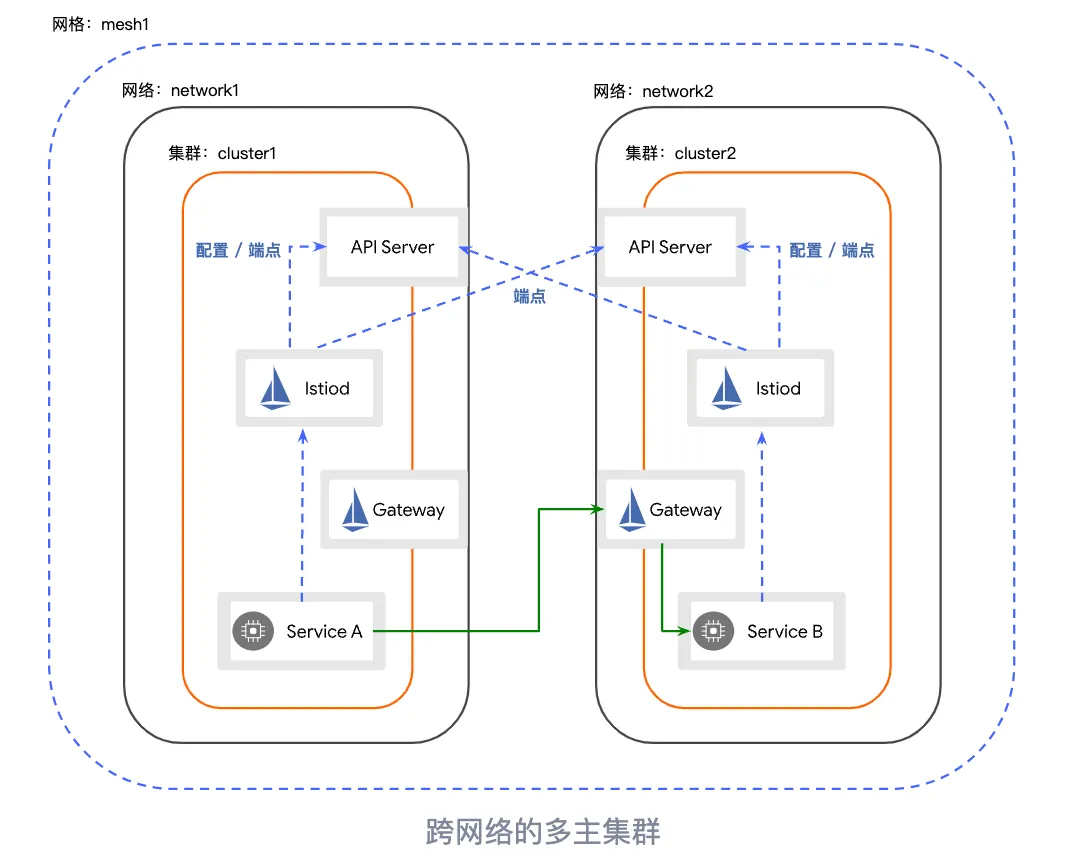
非扁平网络多控制面模型有如下特点。
- 不同的集群不需要在一张大网下,即容器网络不需要三层打通,跨集群的服务访问通过
Istio East-West Gateway转发。 - 每个kubernetes集群的Pod地址范围与服务地址范围没有限制,可以与其他集群重叠,不同集群之间互不干扰
- 每个Kubernetes集群的Sidecar仅连接到本集群的Istio控制面,通信效率更高。
- Istiod只监听主集群的Istio配置,因此
VirtualService、DestinationRule、Gateway等资源存在冗余复制问题 - 同一集群内部服务访问: Pod之间直接连接;跨集群的服务访问:依赖DNS代理解析其他集群的服务域名,由于集群之间的网络相互隔离,所以依赖Remote集群的
East-west Gateway中转流量。
三 ClusterMesh 环境搭建
搭建 cluster1 和 cluster2 两个集群,然后每个集群上安装 Istio 控制平面, 且将两者均设置为主集群(primary cluster)。 集群 cluster1 在 network1 网络上,而集群 cluster2 在 network2 网络上。
3.1 前提条件
1、本次搭建环境信息如下: 使用Kind搭建Kubernetes集群,Kind版本为v0.19.0。 Kubernetes 版本为1.27.3 ; Istio 版本为 1.20.1。

2、下载istioctl二进制curl -L https://istio.io/downloadIstio | ISTIO_VERSION=1.20.1 TARGET_ARCH=x86_64 sh -将 istioctl 客户端添加到路径

3.2 Kubernetes集群安装
- cluster1和cluster2集群安装脚本如下
# create-cluster.sh
# This script handles the creation of multiple clusters using kind and the
# ability to create and configure an insecure container registry.
set -o xtrace
set -o errexit
set -o nounset
set -o pipefail
# shellcheck source=util.sh
NUM_CLUSTERS="${NUM_CLUSTERS:-2}"
KIND_IMAGE="${KIND_IMAGE:-}"
KIND_TAG="${KIND_TAG:-v1.27.3@sha256:3966ac761ae0136263ffdb6cfd4db23ef8a83cba8a463690e98317add2c9ba72}"
OS="$(uname)"
function create-clusters() {
local num_clusters=${1}
local image_arg=""
if [[ "${KIND_IMAGE}" ]]; then
image_arg="--image=${KIND_IMAGE}"
elif [[ "${KIND_TAG}" ]]; then
image_arg="--image=kindest/node:${KIND_TAG}"
fi
for i in $(seq "${num_clusters}"); do
kind create cluster --name "cluster${i}" "${image_arg}"
fixup-cluster "${i}"
echo
done
}
function fixup-cluster() {
local i=${1} # cluster num
if [ "$OS" != "Darwin" ];then
# Set container IP address as kube API endpoint in order for clusters to reach kube API servers in other clusters.
local docker_ip
docker_ip=$(docker inspect --format='{{range .NetworkSettings.Networks}}{{.IPAddress}}{{end}}' "cluster${i}-control-plane")
kubectl config set-cluster "kind-cluster${i}" --server="https://${docker_ip}:6443"
fi
# Simplify context name
kubectl config rename-context "kind-cluster${i}" "cluster${i}"
}
echo "Creating ${NUM_CLUSTERS} clusters"
create-clusters "${NUM_CLUSTERS}"
kubectl config use-context cluster1
echo "Kind CIDR is $(docker network inspect -f '{{$map := index .IPAM.Config 0}}{{index $map "Subnet"}}' kind)"
echo "Complete"以上集群安装的过程中,为了istiod能够访问对方集群的apiserver地址,集群kube-apiserver的地址设置为master节点的地址。因为是kind部署的集群,两个集群的master节点本质上都是同个宿主机上的docker运行的容器。

2、确认cluster1和cluster2 是否就绪

3.3 使用MetalLB为网关分配ExternalIP
由于使用的是kind部署多集群,istio南北向网关和东西向网关创建需要创建LoadBalencer service,均需要使用到ExternalIP。这里借助metalLB 实现LB ip地址的分发和宣告。
查看kind搭建集群使用节点子网网段: 172.18.0.0/16
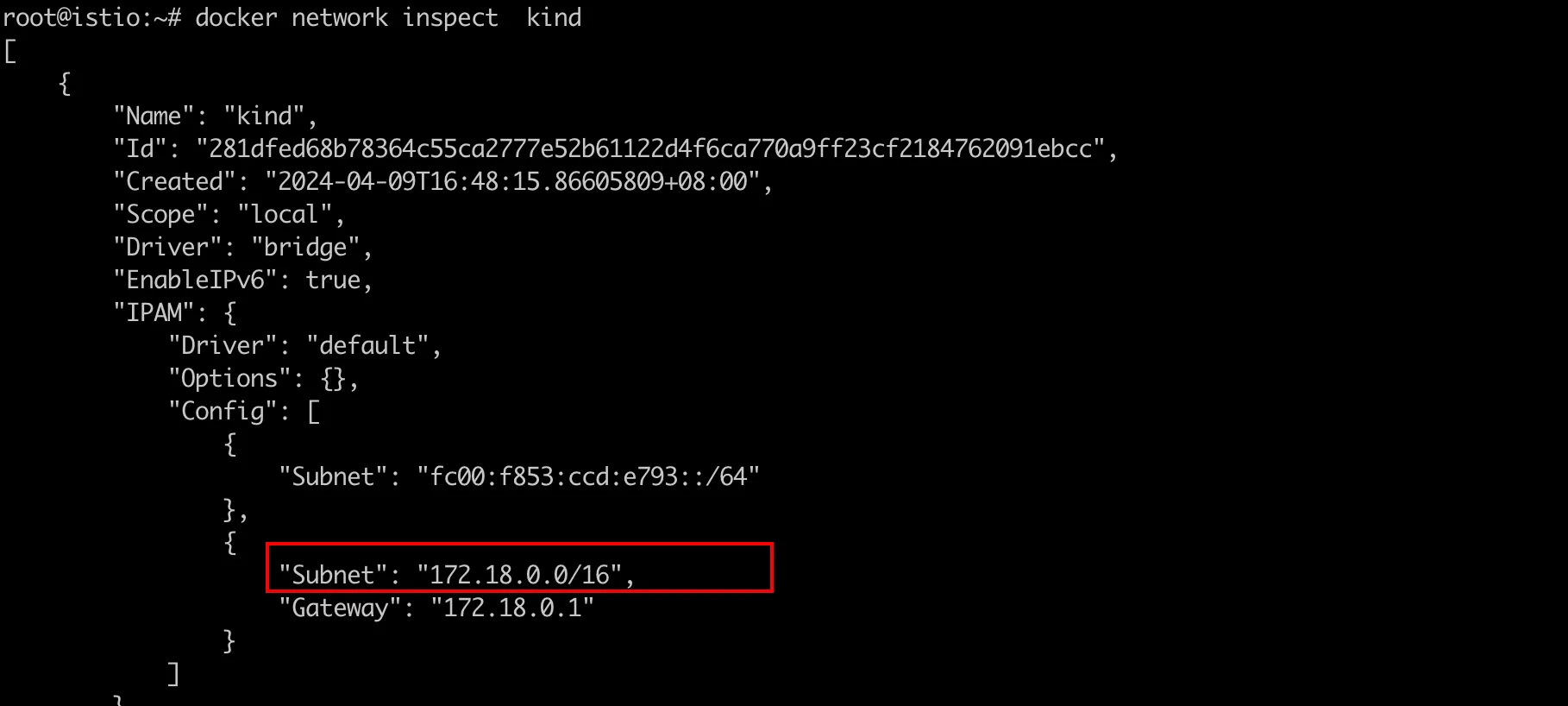
采用metalLB L2模式进行部署。
1、cluster1中的metalLB配置清单: metallb-config-1.yaml
### for cluster1
##配置IPAddressPool,用于lbip地址的分配。L2模式下,ippool地址和worker节点处于同一子网即可
apiVersion: metallb.io/v1beta1
kind: IPAddressPool
metadata:
name: first-pool
namespace: metallb-system
spec:
addresses:
- 172.18.1.230-172.18.1.240
---
##配置L2Advertisement,用于地址宣告
apiVersion: metallb.io/v1beta1
kind: L2Advertisement
metadata:
name: first-adv
namespace: metallb-system
spec:
ipAddressPools:
- first-pool2、cluster2集群中的metalLB配置清单:metallb-config-2.yaml
### for cluster2
##配置IPAddressPool,用于lbip地址的分配。L2模式下,ippool地址和worker节点处于同一子网即可
apiVersion: metallb.io/v1beta1
kind: IPAddressPool
metadata:
name: second-pool
namespace: metallb-system
spec:
addresses:
- 172.18.1.241-172.18.1.252
---
##配置L2Advertisement,用于地址宣告
apiVersion: metallb.io/v1beta1
kind: L2Advertisement
metadata:
name: second-adv
namespace: metallb-system
spec:
ipAddressPools:
- second-pool3、使用脚本进行安装
#!/usr/bin/env bash
set -o xtrace
set -o errexit
set -o nounset
set -o pipefail
NUM_CLUSTERS="${NUM_CLUSTERS:-2}"
for i in $(seq "${NUM_CLUSTERS}"); do
echo "Starting metallb deployment in cluster${i}"
kubectl apply -f https://raw.githubusercontent.com/metallb/metallb/v0.13.10/config/manifests/metallb-native.yaml --context "cluster${i}"
kubectl create secret generic -n metallb-system memberlist --from-literal=secretkey="$(openssl rand -base64 128)" --context "cluster${i}"
## 增加等待时间,如果metallb负载没部署起来,创建IPAddressPool L2Advertisement 会报错
sleep 10
kubectl apply -f ./metallb-config-${i}.yaml --context "cluster${i}"
echo "----"
done4、确认metalLB部署情况

确认IPAddressPool信息:

3.4 集群共享根CA 配置信任关系
为了支持安全的跨集群mTLS通信,多控制面模型要求每个集群的控制面Istiod都使用相同的CA机构颁发的中间CA证书,供Citatel签发证书使用,以支持跨集群的TLS双向认证。
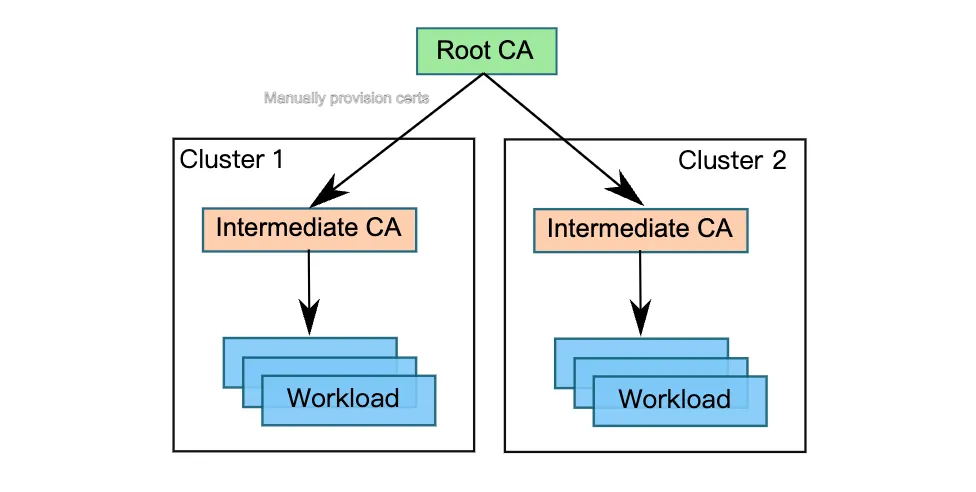
Istio东西向网关(跨集群访问)工作时使用基于SNI的路由,它根据TLS请求的SNI,自动将其路由到SNI对应的Cluster,因此非扁平网络的跨网络访问要求所有流量都必须经过TLS加密。
1、在集群中插入证书和密钥,脚本如下(需要将该脚本移动到istio的安装包目录下):
#!/usr/bin/env bash
set -o xtrace
#set -o errexit
set -o nounset
set -o pipefail
NUM_CLUSTERS="${NUM_CLUSTERS:-2}"
##在istio安装包的顶层目录下 创建目录 用来存放证书和密钥
mkdir -p certs
pushd certs
##生成根证书和密钥
make -f ../tools/certs/Makefile.selfsigned.mk root-ca
for i in $(seq "${NUM_CLUSTERS}"); do
##对于每个集群,为 Istio CA 生成一个中间证书和密钥
make -f ../tools/certs/Makefile.selfsigned.mk "cluster${i}-cacerts"
##对于每个集群,创建istio-system 命名空间
kubectl create namespace istio-system --context "cluster${i}"
## 对于每个集群,通过给istio系统命名空间打上topology.istio.io/network 标签添加网络标识
kubectl --context="cluster${i}" label namespace istio-system topology.istio.io/network="network${i}"
##对于每个集群,给工作节点node打上地域和可用区标签,便于istio实现地域故障转移、地域负载均衡
kubectl --context="cluster${i}" label node "cluster${i}-control-plane" topology.kubernetes.io/region="region${i}"
kubectl --context="cluster${i}" label node "cluster${i}-control-plane" topology.kubernetes.io/zone="zone${i}"
#在每个集群中,创建一个私密 cacerts,使用所有输入文件 ca-cert.pem, ca-key.pem,root-cert.pem 和 cert-chain.pem。
kubectl delete secret cacerts -n istio-system --context "cluster${i}"
kubectl create secret generic cacerts -n istio-system --context "cluster${i}" \
--from-file="cluster${i}/ca-cert.pem" \
--from-file="cluster${i}/ca-key.pem" \
--from-file="cluster${i}/root-cert.pem" \
--from-file="cluster${i}/cert-chain.pem"
echo "----"
done2、执行脚本,将会生成根证书和中间证书等文件

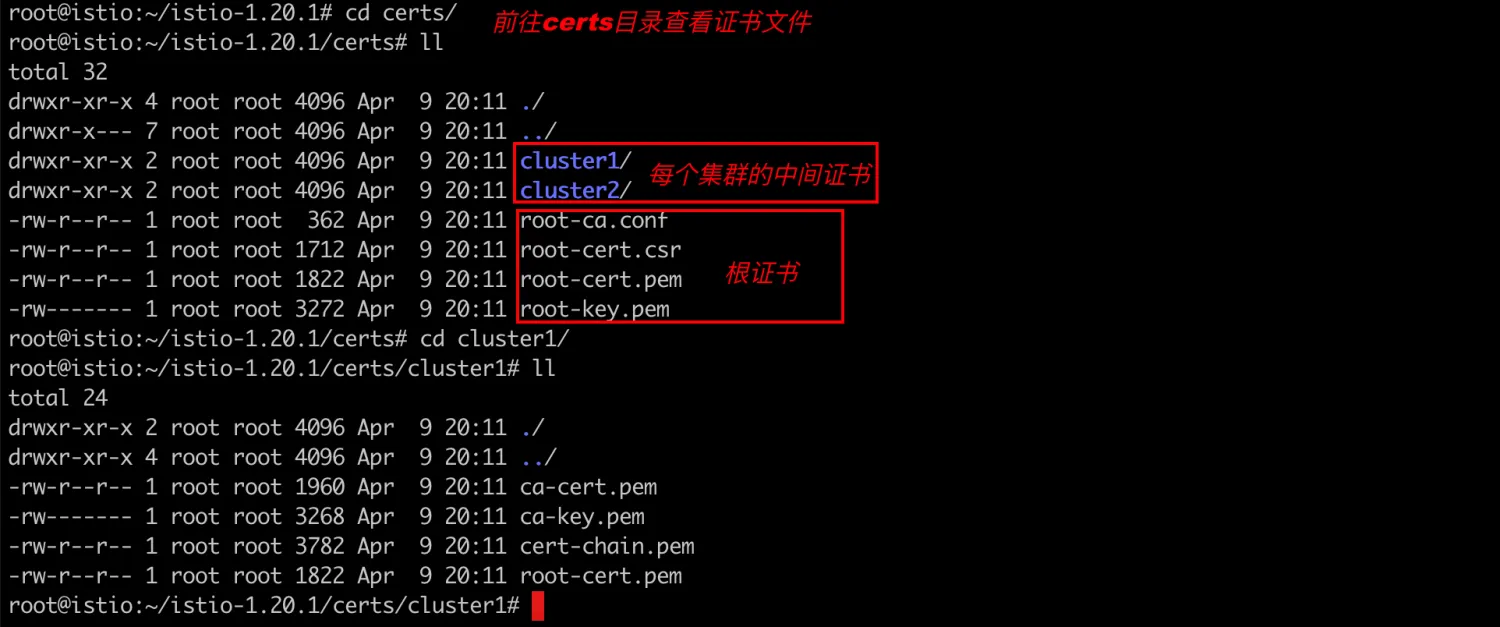
3.5 Istio服务网格安装
为cluster1,和cluster2 集群安装多控制面istio网格。
1、将cluster1 设置为主集群,在istio的安装目录下执行如下命令
cat <<EOF > cluster1.yaml
apiVersion: install.istio.io/v1alpha1
kind: IstioOperator
spec:
values:
global:
meshID: mesh1
multiCluster: ##开启多集群配置
clusterName: cluster1 #指定k8s集群名称
network: network1 #指定网络标识
logging:
level: debug
EOF2、将cluster2 设置为主集群,在istio的安装目录下执行如下命令
cat <<EOF > cluster2.yaml
apiVersion: install.istio.io/v1alpha1
kind: IstioOperator
spec:
values:
global:
meshID: mesh2
multiCluster: ##开启多集群配置
clusterName: cluster2 #指定k8s集群名称
network: network2 #指定网络标识
logging:
level: debug
EOF- 编写自动化安装脚本
#!/usr/bin/env bash
set -o xtrace
set -o errexit
set -o nounset
set -o pipefail
OS="$(uname)"
NUM_CLUSTERS="${NUM_CLUSTERS:-2}"
for i in $(seq "${NUM_CLUSTERS}"); do
echo "Starting istio deployment in cluster${i}"
istioctl install --force --context="cluster${i}" -f "cluster${i}.yaml"
echo "Generate eastwest gateway in cluster${i}"
## 在每个集群中安装东西向网关。
bash samples/multicluster/gen-eastwest-gateway.sh \
--mesh "mesh${i}" --cluster "cluster${i}" --network "network${i}" | \
istioctl --context="cluster${i}" install -y -f -
echo
done4、执行脚本,进行istio的安装部署
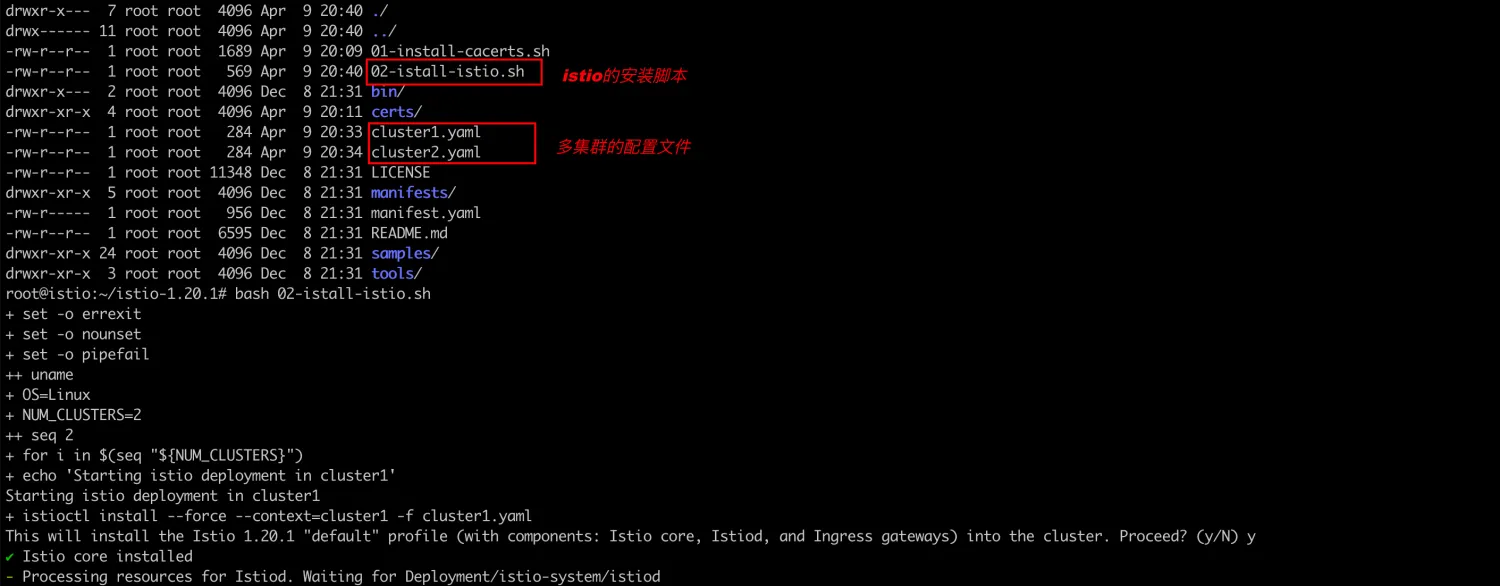
稍等片刻后,等待安装完成

可以发现每个集群中的网关使用的ExternalIP信息为配置的metalLB设置的IPPool中的地址。
3.6 在东西向网关开放服务
因为集群位于不同的网络中,所以我们需要在两个集群东西向网关上开放所有服务(*.local)。 虽然此网关在互联网上是公开的,但它背后的服务只能被拥有可信 mTLS 证书的服务访问, 就像它们处于同一网络一样。执行下面的命令在两个集群中暴露服务:
apiVersion: networking.istio.io/v1beta1
kind: Gateway
metadata:
name: cross-network-gateway
spec:
selector:
istio: eastwestgateway # 专用于东西向流量的网关
servers:
- port:
number: 15443 # 已经声明了
name: tls
protocol: TLS
tls:
mode: AUTO_PASSTHROUGH # 东西向网关工作模式是 TLS AUTO_PASSTHROUGH
hosts:
- "*.local" # 暴露所有的服务分别在每个集群中应用上述Gateway配置:
kubectl -n istio-system --context=cluster${i} apply -f samples/multicluster/expose-services.yaml

3.7 配置secret以便istiod访问远程集群apiserver
每个k8s集群中的 istiod 需要 List-Watch 其他集群的 Kube-APIServer,使用 K8s 集群的凭据来创建 Secret 对象,以允许 Istio 访问远程 Kubernetes apiserver。
#!/usr/bin/env bash
set -o xtrace
set -o errexit
set -o nounset
set -o pipefail
OS="$(uname)"
NUM_CLUSTERS="${NUM_CLUSTERS:-2}"
for i in $(seq "${NUM_CLUSTERS}"); do
for j in $(seq "${NUM_CLUSTERS}"); do
if [ "$i" -ne "$j" ]
then
echo "Enable Endpoint Discovery between cluster${i} and cluster${j}"
if [ "$OS" == "Darwin" ]
then
# Set container IP address as kube API endpoint in order for clusters to reach kube API servers in other clusters.
docker_ip=$(docker inspect -f '{{range.NetworkSettings.Networks}}{{.IPAddress}}{{end}}' "cluster${i}-control-plane")
istioctl create-remote-secret \
--context="cluster${i}" \
--server="https://${docker_ip}:6443" \
--name="cluster${i}" | \
kubectl apply --validate=false --context="cluster${j}" -f -
else
istioctl create-remote-secret \
--context="cluster${i}" \
--name="cluster${i}" | \
kubectl apply --validate=false --context="cluster${j}" -f -
fi
fi
done
done执行以上脚本:remote secret创建完成。

查看istiod日志发现已经监听远程集群了

四 Istio多集群流量治理实践

1、每个集群创建sample 命名空间,并设置sidecar自动注入
kubectl create --context=cluster1 namespace sample
kubectl create --context=cluster2 namespace sample
kubectl label --context=cluster1 namespace sample \
istio-injection=enabled
kubectl label --context=cluster2 namespace sample \
istio-injection=enabled
kubectl apply --context=cluster1 \
-f samples/helloworld/helloworld.yaml \
-l service=helloworld -n sample
kubectl apply --context=cluster2 \
-f samples/helloworld/helloworld.yaml \
-l service=helloworld -n sample2、分别在不同集群部署不同版本的服务
把应用 helloworld-v1 部署到 cluster1:
kubectl apply --context=cluster1 \
-f samples/helloworld/helloworld.yaml \
-l version=v1 -n sample把应用 helloworld-v2 部署到 cluster2:
kubectl apply --context=cluster2 \
-f samples/helloworld/helloworld.yaml \
-l version=v2 -n sample3、部署测试客户端
kubectl apply --context=cluster1 \
-f samples/sleep/sleep.yaml -n sample
kubectl apply --context=cluster2 \
-f samples/sleep/sleep.yaml -n sample4、确认负载实例部署成功,并且sidecar已经注入
4.1 验证跨集群流量
用 Sleep pod 重复调用服务 HelloWorld。 为了确认负载均衡按预期工作,需要从所有集群调用服务 HelloWorld。
- 从 cluster1 中的 Sleep pod 发送请求给服务 HelloWorld
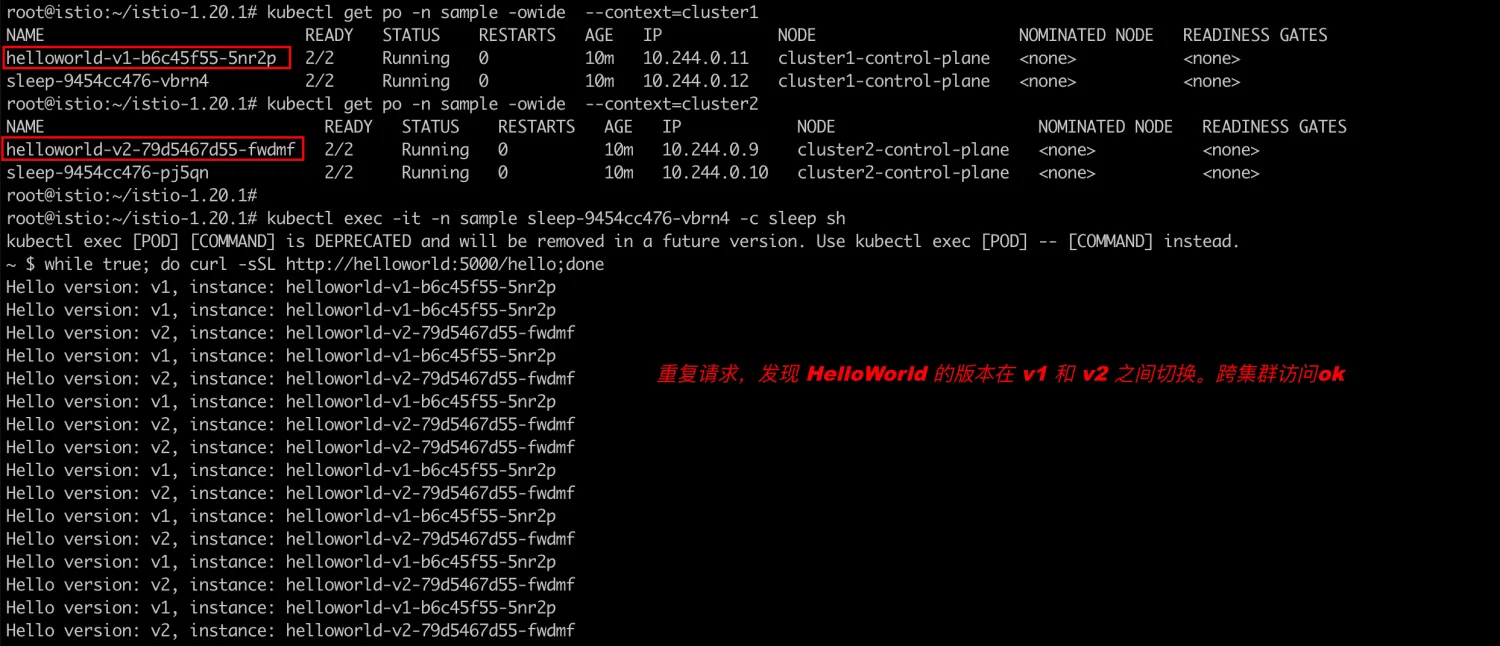
- 从 cluster2 中的 Sleep pod 发送请求给服务 HelloWorld
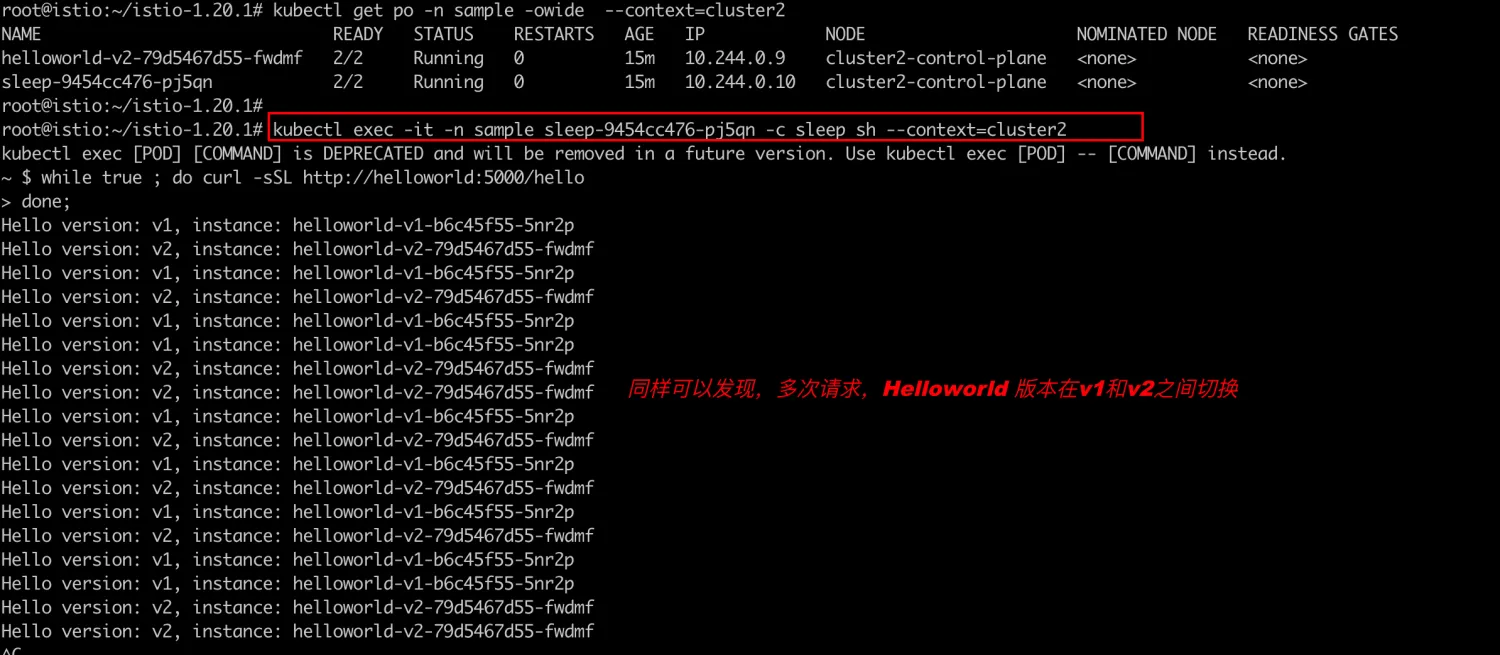
4.3 验证从网关访问
通过网关访问服务端Helloworld
1、创建virtualservice、gateway等istio资源,配置清单如下
# helloworld-gateway.yaml
apiVersion: networking.istio.io/v1beta1
kind: Gateway
metadata:
name: helloworld-gateway
spec:
selector:
istio: ingressgateway # use istio default controller
servers:
- port:
number: 80
name: http
protocol: HTTP
hosts:
- "*"
---
apiVersion: networking.istio.io/v1beta1
kind: VirtualService
metadata:
name: helloworld
spec:
hosts:
- "*"
gateways:
- helloworld-gateway
http:
- match:
- uri:
exact: /hello
route:
- destination:
host: helloworld
port:
number: 5000注意: 两个集群都需要应用该配置
2、访问效果如下:

4.3 验证地域负载均衡
1、对流量进行更精细的控制,将 region1 -> zone1 和 region1 -> zone2 两个地区的权重分别为 80% 和 20%,使用 DestinationRule 来配置权重分布
# locality-lb-weight.yaml
apiVersion: networking.istio.io/v1beta1
kind: DestinationRule
metadata:
name: helloworld
namespace: sample
spec:
host: helloworld.sample.svc.cluster.local
trafficPolicy:
connectionPool:
http:
maxRequestsPerConnection: 1
loadBalancer:
simple: ROUND_ROBIN
localityLbSetting:
enabled: true
distribute:
- from: region1/*
to:
"region1/*": 80
"region2/*": 20
- from: region2/*
to:
"region2/*": 80
"region1/*": 20
outlierDetection:
consecutive5xxErrors: 1
interval: 1s
baseEjectionTime: 1m注意: 两个集群都需要应用该配置
2、从 cluster1 中通过网关发送请求给服务 HelloWorld
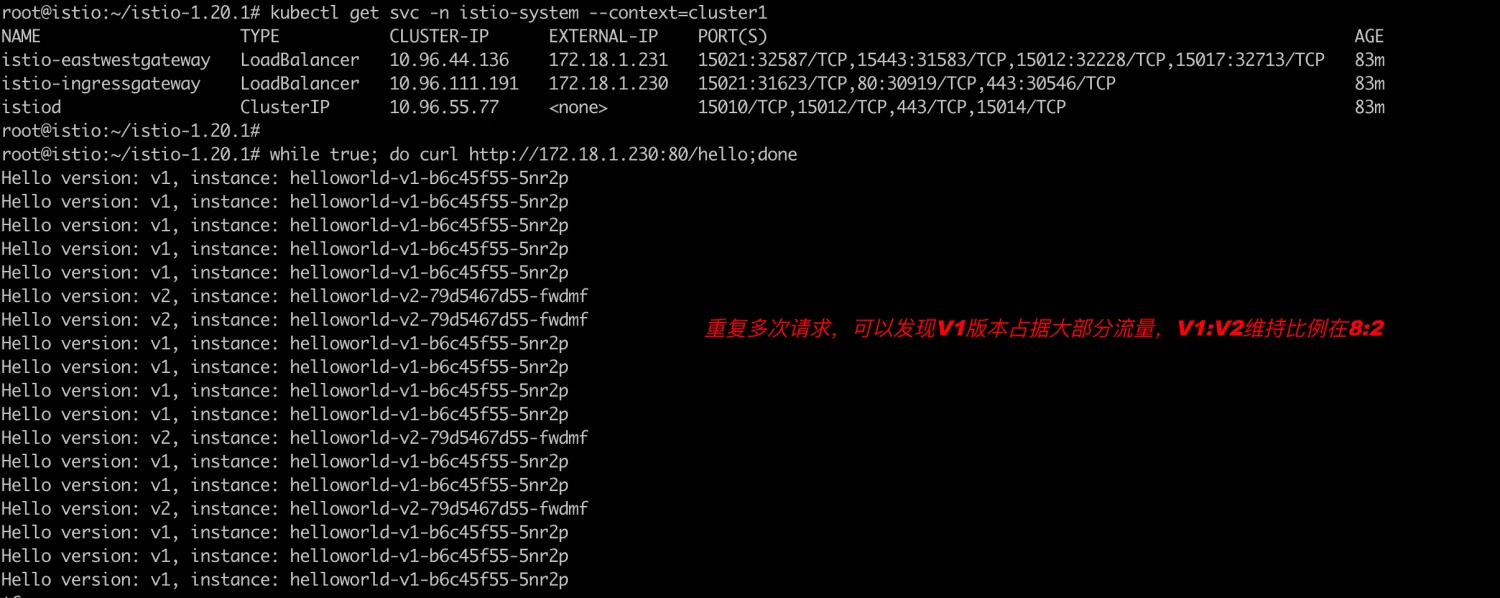
3、从 cluster2中通过网关发送请求给服务 HelloWorld
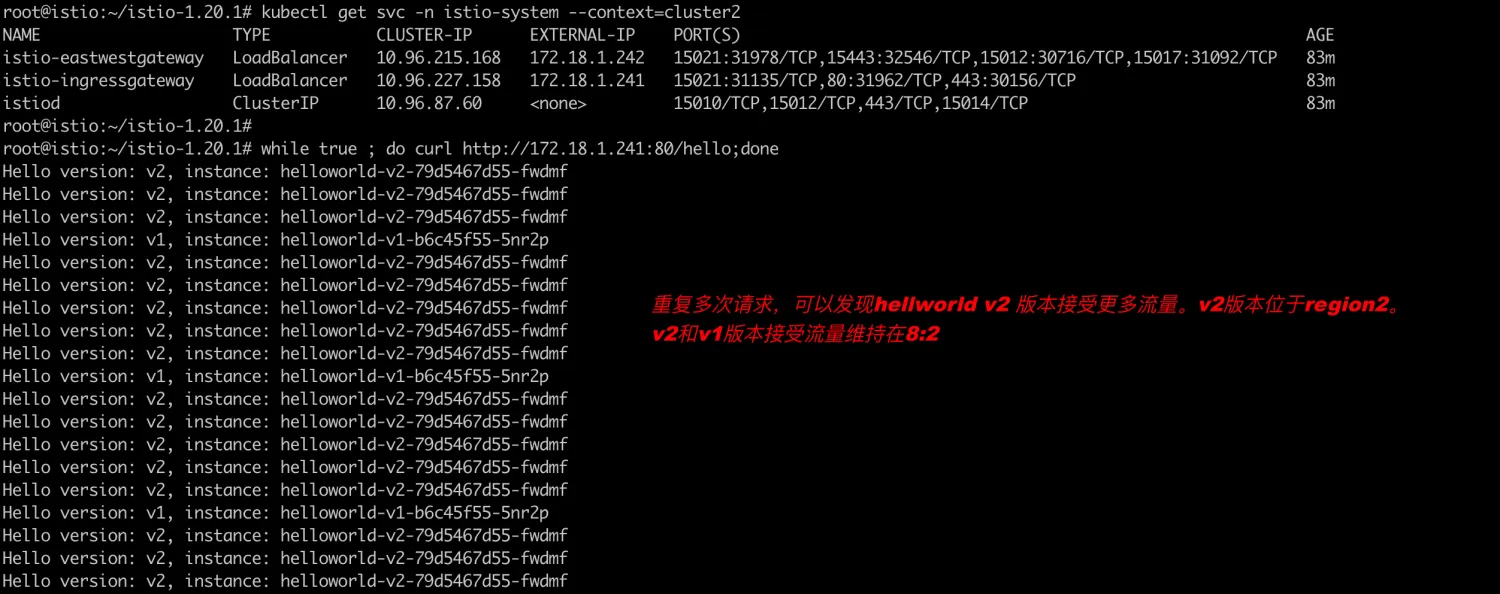
4.4 验证地域故障转移
1、当多个地区/区域部署多个服务实例时,如果某个地区/区域的服务实例不可用,可以将流量转移到其他地区/区域的服务实例上,实现地域故障转移,这样就可以保证服务的高可用性。
# locality-lb-failover.yaml
apiVersion: networking.istio.io/v1beta1
kind: DestinationRule
metadata:
name: helloworld
namespace: sample
spec:
host: helloworld.sample.svc.cluster.local
trafficPolicy:
connectionPool:
http:
maxRequestsPerConnection: 1 # 关闭 HTTP Keep-Alive,强制每个HTTP请求使用一个新连接的策略
loadBalancer:
simple: ROUND_ROBIN
localityLbSetting: # 地域负载均衡配置,开启异常点检测后,默认开启。
enabled: true
failover: # 地域故障转移策略
- from: region1
to: region2
- from: region2
to: region1
outlierDetection:
consecutive5xxErrors: 1 # 连续 1 次 5xx 错误
interval: 1s # 检测间隔 1s
baseEjectionTime: 1m # 基础驱逐时间 1m注意: 两个集群都需要应用该配置
2、从 cluster1 中通过网关发送请求给服务 HelloWorld

3、模拟故障,手动将cluster1集群中Helloworld V1版本设置故障

再次访问,故障检测生效,触发故障转移,并验证响应中的 version 始终为 v2,也就是说我们访问的是 region2 的 helloworld 服务,这样就实现了地域故障转移。

4、故障转移的前提是当前region内,所有实例都不可用时,才会转移到到目前region,否则流量还会发往当前region的其他可用实例。
五 备注
参考文献如下:
- istio开源社区(跨网络多主架构的安装说明): https://istio.io/latest/zh/docs/setup/install/multicluster/multi-primary_multi-network/
- kind安装集群脚本参考: https://github.com/cnych/multi-cluster-istio-kind/tree/main/kind-create
- 多集群证书管理参考:https://istio.io/latest/zh/docs/tasks/security/cert-management/plugin-ca-cert/
点击关注,第一时间了解华为云新鲜技术~










